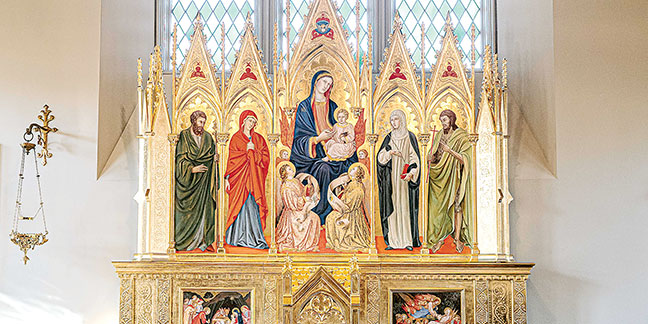Old World grandeur created anew
 After reviving the centuries-old Sienese technique of egg tempera, Italian artist Chiara Perinetti Casoni created a unique five-panel piece on gold leaf for St. Joseph College Seminary. It features five saints with special meaning to the seminary and the priesthood as well as two scenes from the earthly lives of Jesus and Mary. (Photos by Siobhan Lorraine Photography)MOUNT HOLLY — The 90-acre campus of St. Joseph College Seminary is quickly becoming the center of an artistic renaissance. With its revival of classic language, learning, music and devotional practices underway, the fine arts were a natural addition to the seminary’s milieu.
After reviving the centuries-old Sienese technique of egg tempera, Italian artist Chiara Perinetti Casoni created a unique five-panel piece on gold leaf for St. Joseph College Seminary. It features five saints with special meaning to the seminary and the priesthood as well as two scenes from the earthly lives of Jesus and Mary. (Photos by Siobhan Lorraine Photography)MOUNT HOLLY — The 90-acre campus of St. Joseph College Seminary is quickly becoming the center of an artistic renaissance. With its revival of classic language, learning, music and devotional practices underway, the fine arts were a natural addition to the seminary’s milieu.
Its latest work is a polyptych: a 12-foot-tall, five-panel piece by Italian artist Chiara Perinetti Casoni, who uses egg tempera (paint made of egg yolk and color pigments) painted on gold leaf, a style that flourished in Siena, Italy, between the 13th and 15th centuries.
“The first time I saw the beautiful painting on gold, I was captured,” says Casoni, who studied old Latin texts to revive this Sienese artistic tradition.
The piece will be prominently displayed in the seminary’s new chapel, which is set to break ground this spring. It will be placed behind the sanctuary in the Lady Chapel, which will house the Blessed Sacrament and will be visible from the nave.
Once commonly used as altarpieces, especially during the early Renaissance period, the polyptych is considered a rare work of art today.
“Frankly, there is nothing of this scale and grandeur that has been done anywhere in centuries. It is, for our age, one of a kind,” says Father Matthew Kauth, rector of the college seminary.
The piece holds special significance to the college seminary and its rector, who was inspired by this form of art while living in Siena in 2008 and returning there during school breaks. He says the style is unique to the city and lends itself well to contemplation.
Paintings of St. Joseph, St. Mary Magdalene, the Blessed Virgin Mary with the Christ Child, St. Catherine of Siena, and St. John the Baptist grace the piece’s wooden panels.
“Our Lady is depicted ‘in trono’ as the throne of Christ, wisdom incarnate,” Father Kauth explains. “This is the central image of the Sienese polyptych.”
The other saints included on the piece are relevant to the mission of a priest and his formation: St. John the Baptist is a friend of the bridegroom. Mary Magdalen and St. Catherine of Siena are images of the Church for whom these seminarians will one day care for, each having a significant role in preaching the Gospel. And finally, St. Joseph is represented as the seminary’s patron.
Depicted below the saints are scenes of the Epiphany and the Assumption of the Blessed Virgin Mary, two events bookending the earthly lives of Mary and her Son.
After Father Kauth returned to the United States from Italy, he eventually met Mary Clark, who was interested in becoming a sacred artist. He encouraged her to learn the Sienese style of egg tempera and began searching for someone in Siena who still engaged in the art form to teach her.
“That search led me to a small bottega where siblings Chiara, Michelangelo and Paolo continued the tradition. They were not Sienese themselves but came there to learn, perfect, and carry on this tradition,” he says. “Once I saw what they could accomplish in their small paintings, the idea of a polyptych began to materialize. By their nature, polyptychs direct the gaze and devotion of the visitor.”
This masterpiece took over five years to complete, with several artists and artisans involved.
“The symbolism of the piece developed over time, as did the size and content,” Father Kauth says. “It grew as our understanding of what we wanted to communicate grew. One example is the Christological finch, which the Child Jesus embraces as a sign of His future passion.”
The polyptych was made possible through donations by a few dedicated friends of the seminary. Right now, it is displayed in the sanctuary of the seminary’s current chapel. Father
Kauth emphasizes that although the piece has special meaning to the seminary, it is a gift to all Catholics in the area.
“I would encourage anyone in our diocese to come and spend some time in prayer before the polyptych, for while it enriches our daily life of prayer, it is also meant to enrich the lives of all our faithful,” he says. “Come and make a pilgrimage to see it!”
— Annie Ferguson
Plan a visit
To schedule a visit to St. Joseph College Seminary, contact Director of Advancement Fredrik Akerblom at This email address is being protected from spambots. You need JavaScript enabled to view it.. Learn more and support their work at www.stjcs.org.












